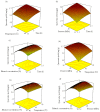Optimization of process parameters of extraction of amentoflavone, quercetin and ginkgetin from Taxus chinensis using supercritical CO2 plus co-solvent
- PMID: 25365294
- PMCID: PMC6270813
- DOI: 10.3390/molecules191117682
Optimization of process parameters of extraction of amentoflavone, quercetin and ginkgetin from Taxus chinensis using supercritical CO2 plus co-solvent
Abstract
The effects of extraction time, temperature, pressure and different concentration of ethanol and their interactions on the yields of amentoflavone, quercetin and ginkgetin extracted from Taxus chinensis by supercritical CO2 were investigated by using a central composite design (CCD). An CCD experimental design with four factors and five levels was used to optimize the extraction parameters. Ultra performance liquid chromatography (UPLC) was used to analyze the content of the tree components in the extracts. Experimental results show that the main effects of factors and their interactions are significant on the yields (p < 0.05). The optimal extraction conditions were established for the three compounds: yield of 4.47 mg/g for amentoflavone at 48 °C, 25 MPa, 2.02 h and 78.5% ethanol, 3.73 mg/g for quercetin at 46 °C, 24 MPa, 2.3 h, 82% ethanol and 3.47 mg/g for ginkgetin at 48 °C, 20 MPa, 2.38 h, 82% ethanol, respectively.
Conflict of interest statement
The authors declare no conflict of interest.
Figures







References
-
- Rezende T.P., Correa J.O., Aarestrup B.J., Aarestrup F.M., de Sousa O.V., da Silva Filho A.A. Protective effects of Baccharis dracunculifolia leaves extract against carbon tetrachloride- and acetaminophen-induced hepatotoxicity in experimental animals. Molecules. 2014;19:9257–9272. doi: 10.3390/molecules19079257. - DOI - PMC - PubMed
Publication types
MeSH terms
Substances
LinkOut - more resources
Full Text Sources
Other Literature Sources

